Language
- Deutsch
- English
- Español
- Français
- Italiano
- Nederlands
- Português
Currency
- AUD Australian Dollar
- CAD Canadian Dollar
- EUR Euro
- GBP Pound Sterling
- SGD Singapore Dollar
- USD US Dollar
- ZAR Rand

why go
Namibia is a place where the concept of ‘vastness’ can not only be truly comprehended, but also felt. It is of course the gigantic, incomparable sand dunes of the ancient Namib Desert that feature most prominently on a Namibia holiday itinerary. But this Southern African country, lying between the Kalahari and the Atlantic Ocean, has much more up its sleeve.
Huge, sparsely populated Namibia is a country of gigantic skies and dramatic scenery. Destinations such as Damaraland, the shipwreck-strewn Skeleton Coast, or the Kaokoveld literally echo with emptiness and atmosphere, yet excellent lodges are tucked away in these remote regions and provide intrepid travellers with havens of serenity and comfort. And there’s a lot more wildlife than you might think!
If spotting unique animals is on your wish list, then the Namibia wildlife won’t disappoint. Excellent game viewing is what you’ll get at Etosha National Park, famous for its animal-packed waterholes and abundant predators. Small populations of desert-adapted elephant, black rhino, giraffe, ostrich, oryx, and lion can be seen in off-the-beaten-path destinations like Damaraland and Kaokoveld. These unique animals have adapted their lifestyles to survive in one of our planet's harshest environments, and spotting them is a highlight on any Namibia safari tour.
A Namibia holiday is ideal for wildlife enthusiasts, while its decent road infrastructure and easy-to-access destinations provide straightforward self-drive safaris for more independent travellers. Some of the best lodges in Namibia are remote, luxurious and exclusive accommodations that make for romantic holidays to Namibia for couples, while families with children will be delighted by the country’s safe, well-functioning and friendly nature.
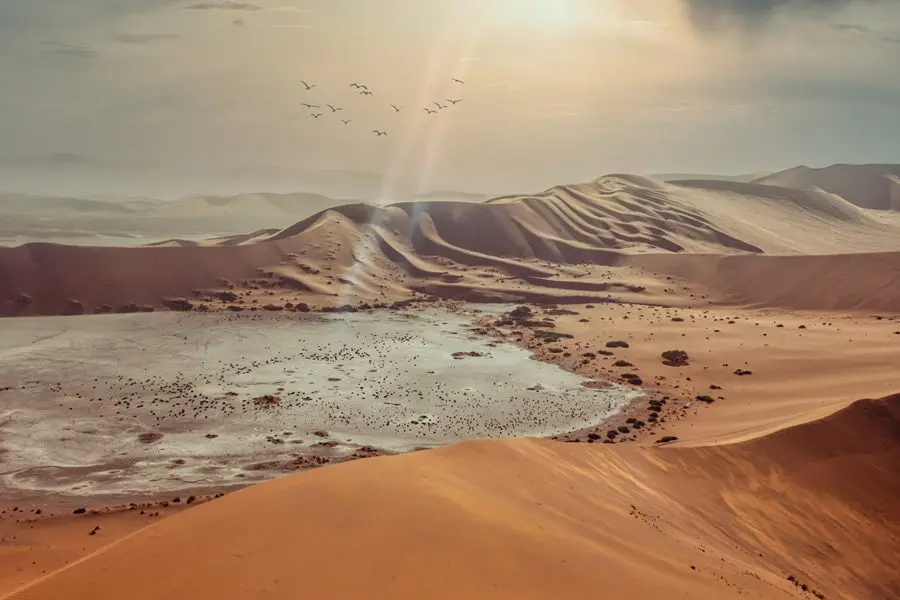
If you've been researching a trip to this country, you've probably come across phrases like ‘Namibia moonscape’ or ‘Namibia welwitschia plains’. The Namib Desert, the oldest desert on Earth, not only makes the country one of the least densely populated places in the world, it's also responsible for providing unrivalled, see-it-to-believe-it Namibia landscapes.
The Namib's enormous sand dunes, arid gravel plains, and mountainous terrain make Namibia’s scenery and landscapes some of the most dramatic you will ever see. In fact, in some areas of Namibia, you’ll feel like you’ve landed on Mars.
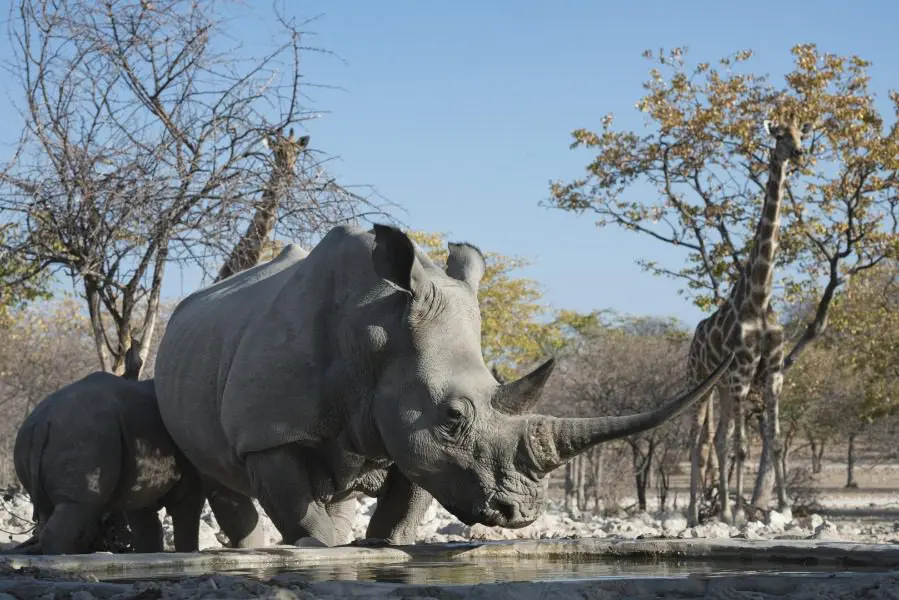
During Namibia's dry season (May to October), the temporary water holes around Etosha Pan become a magnet for animal numbers of biblical proportions. Etosha National Park is dominated by this colossal mineral pan (the size of Holland), while the surrounding grasslands are feeding grounds for dense herds of plains game and Namibia wildlife like elephant, rhino, lion, leopard, cheetah and giraffe.
Damaraland is home to small populations of desert-adapted elephant, black rhino, giraffe, ostrich, oryx and springbok (gazelle). Desert-adapted elephants can travel up to 70 kilometres (40 miles) a day through the desert in search for food and water – and unlike their larger savannah cousins, they don't destroy any trees in their quest for nourishment.
Kaokoveld is an otherworldly and mountainous landscape of rugged beauty. The region is a refuge for rare desert-adapted lion, elephant, black rhino, giraffe and oryx. The nomadic lions of Kaokoveld have adapted their lifestyles to survive in one of the world's harshest environments. Sustenance is difficult to come by in the desert, so these powerful cats have learned how to take down big animals like giraffe and even elephant.
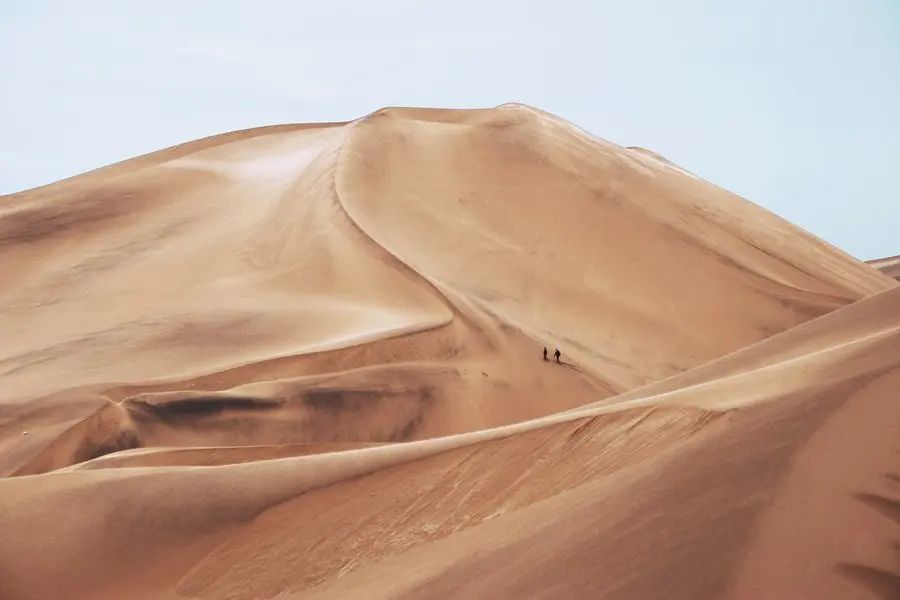
When it comes to sheer scale and natural beauty, Namibia's epic landscapes are hard to beat. Imagine ochre sand dunes more than 300 metres (985 feet) high, soaring inselbergs, or a tempestuous coastline scattered with shipwrecks and whale- and seal bones.
From sandboarding down the dunes of our planet's oldest desert to climbing the granite flanks of the ‘Matterhorn of Africa’, a Namibia vacation offers a plethora of activities for thrill seekers.
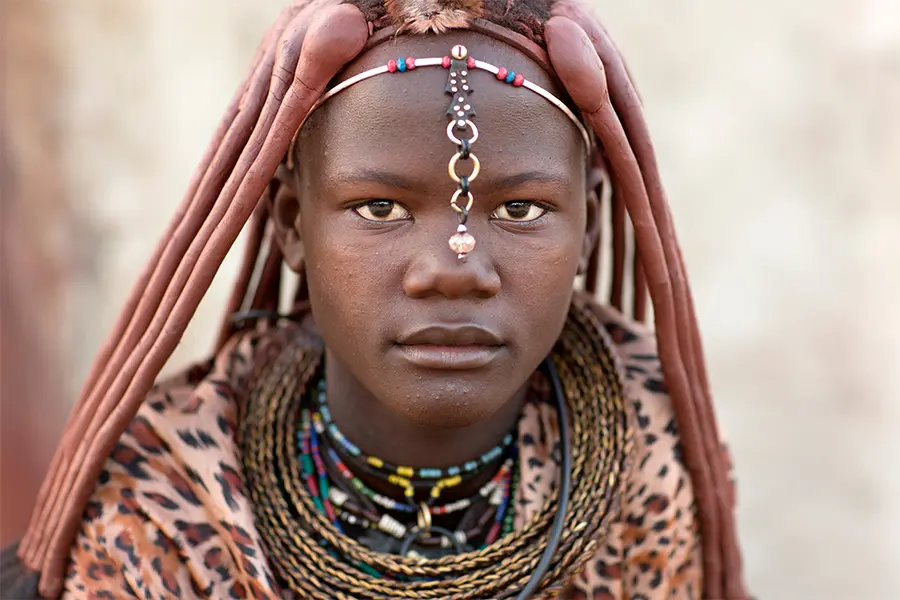
Journey to a remote corner of the Kalahari to meet the San Bushmen. This indigenous hunter-gatherer society still uses Stone Age technology, yet they possess a knowledge of their environment that researchers are only just beginning to comprehend. Their understanding of the natural environment is extraordinary to witness, and their survival skills are beyond belief.
The Himba are an indigenous people living in the Kaokoveld region of northern Namibia. Meeting them is among the top cultural interactions you can have in Africa. They are famous for covering themselves with otjize paste – a cosmetic mixture of butterfat and ochre pigment – to protect themselves from the harsh, hot and dry desert climate. It gives the Himba’s skin and hair a very distinctive style, texture and orange-red tinge.
To make the most of a Namibia holiday, you either need enough time or enough budget. If you have the budget, it's very easy to fly between the remote corners of this colossal country. But if you have ample time and an independent spirit, there's no better country in Africa in which to go on self-drive safaris.
Driving yourself is by no means intrepid exploration. Car hire can be arranged for you with a complete itinerary, detailed maps, and all the information that you'll need to safely enjoy your self-drive Namibia holiday.
Distances may appear daunting, but the country's roads are good, straight and uncrowded. Driving yourself not only gives you complete freedom to create an adventure at your own pace, but it also immerses you in the natural grandeur and sheer emptiness of the Namibia landscapes.
Namibia is a pleasure to drive in. The infrastructure is generally good and well-maintained, and there are few other drivers on the highways (and certainly no gridlocked traffic jams). If you have more than a week to spend, then it is possible to drive to major sites in the north like Windhoek (the capital), Swakopmund and Etosha. The distances are long, and you must be comfortable driving on the left-hand side of the road, being without mobile phone reception in some areas, and changing a burst spare tyre if necessary. An air-conditioned 4×4 makes the journeys a lot more comfortable. Be aware, however, that you will spend every day driving and not have that much time to simply drink in Namibia's unique atmosphere.
It is far better to set aside at least two weeks to drive through Namibia's biggest attractions. This probably won't give you enough time to see the Fish River Canyon, which is way down south near the border with South Africa, but it will allow you to spend a few days in each place and not have to drive every day. No-one wants to spend their annual holiday in a car.
Three weeks will allow you the privilege of taking your time and perhaps even seeing areas like the Skeleton Coast, the Caprivi Strip (which is lush and green thanks to the Okavango, Chobe and Zambezi Rivers) and other out-the-way places. If you have the time, be sure to visit the site of the Gideon meteorite shower, where about 150 meteorites fell to Earth 600 million years ago or the Ombalantu Baobab Tree, which is 800 years old and can fit 35 people in its trunk (which has acted as a church, post office and jail over the years).
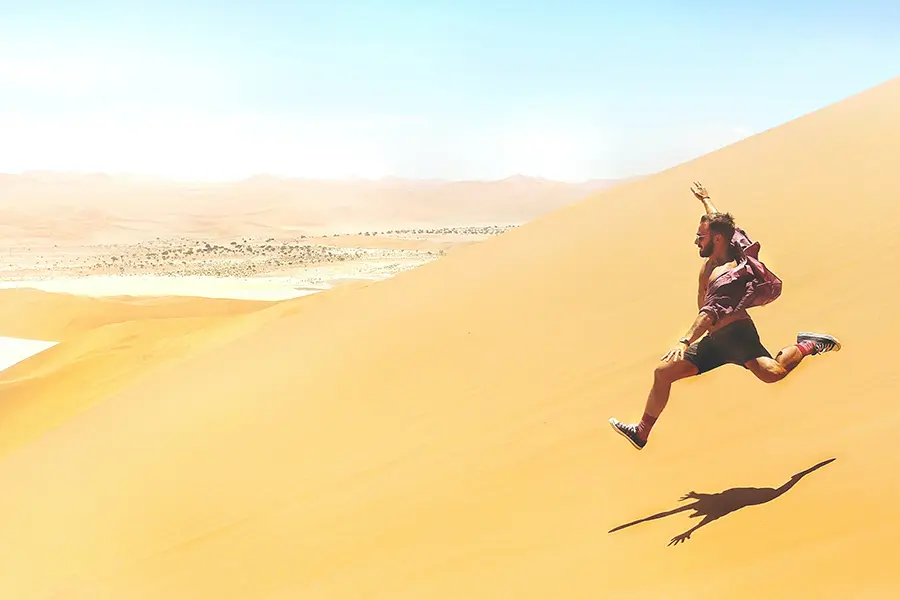
If you want to splurge and see Namibia's spectacular landscapes from the air, then flying between your accommodations by light aircraft is the way to go. A Namibia flying safari costs much more than driving but frees up much more of your time: a drive of several hours is radically condensed, giving you more time to enjoy the lodges, go on game drives or see the sights.
Not all camps have access to airstrips, however, so your itinerary will be influenced by that. Flying is definitely the easiest and most comfortable way to reach remote places like the Skeleton Coast or Kunene, on the Angolan border.
Our suggestion is to combine driving and flying to cut costs, give you some adventure and allow you to maximise your time in Namibia without breaking the bank.
So, for example, you may want to drive from Windhoek to Swakopmund and onto Etosha National Park via Damaraland but fly back to Windhoek from Etosha (a more than 7-hour drive) for your onward flight home. Or, if you are really keen on seeing the Fish River Canyon, cut out the more than 8-hour drive there and back from Windhoek by flying. There are lots of options available and your Africa Safari Expert will be able to consult broadly with you on the best one for your time and budget.
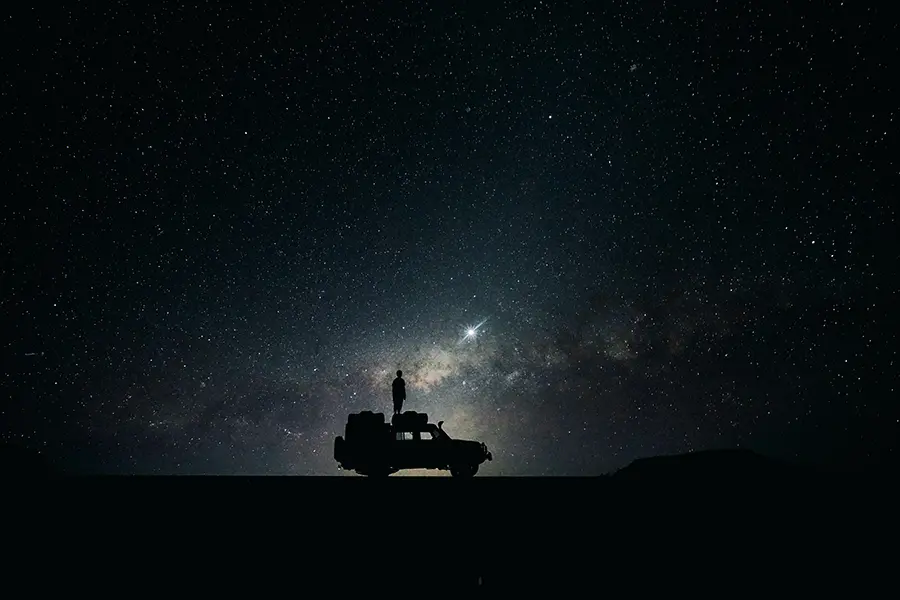
One of the most exciting things ever is to plan your safari. We can easily spend hours daydreaming about the amazing wildlife sightings we're going to have, the delicious sundowners we're going to sip, the amazing people we're going to meet, etcetera. But, like all things, dreams are more likely to become real when they're underpinned by solid plans structured with the help of on-the-ground experts.
Namibia is a dream destination but there are plenty of things to consider:
Most of our clients have visited Africa before and ticked off the ‘biggies' like the Kruger National Park, Cape Town, Victoria Falls, the Serengeti or the Masai Mara before they venture into a more remote destination like Namibia.
Although the scenery can be beautiful, there are very few towns or even petrol/gas stations in Namibia where you can pull over to use a restroom or buy a coffee. Sometimes, a tree on the side of the road is all you'll have, which is part of the fun for our more adventurous travellers.
For hours on end, you may not chat to anyone else so it's best to really get along with your fellow passengers if you're driving around Namibia.
Unless you have plenty of cash and time, it may not be possible to see and do everything that a varied country like Namibia has to offer. Start with your interests and preferences, and work from there. If you prefer history to hiking, then extra days in Swakopmund (where beer is still brewed according to a 1516 German purity law issued in Bavaria) and fewer in Sossusvlei are best for you. If you like birding more than beer, then maximise your time in the Caprivi Strip and lose a day or two in Swakop.
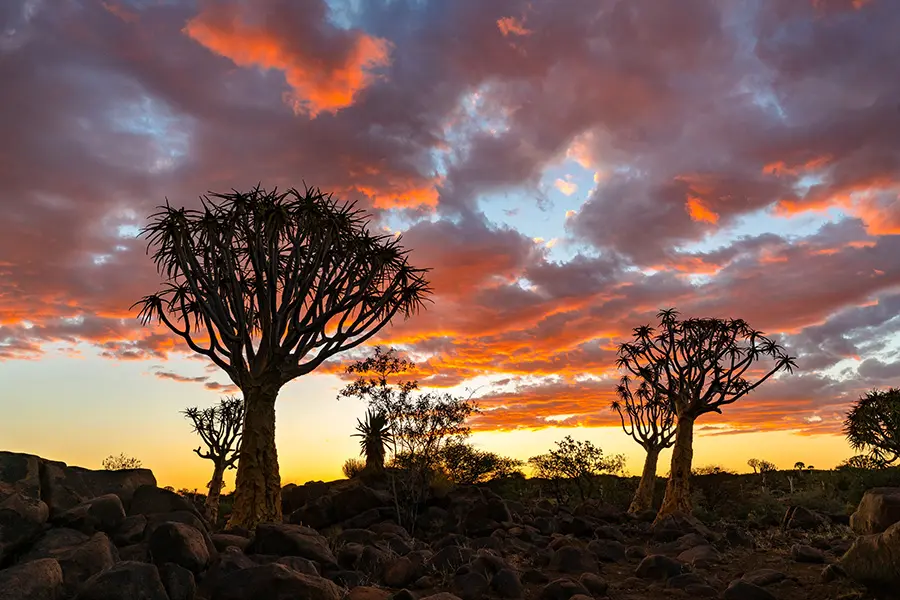
If you want to see Etosha and Damaraland in peak season, then it's best to start planning a year in advance. This may seem extreme and unnecessary, but accommodation is limited and goes fast. If you leave it very late, you may not be able to secure accommodation at all. Availability is a key issue in planning a thorough and satisfactory Namibia itinerary.
Family rooms can be hard to secure if three or more of you are travelling together – another great reason to plan as soon as you can. If you're travelling with young children, bear in mind that those under six are often not accommodated on open game-drive vehicles. Some guides may also not stop at predator sightings if there are kids in an open vehicle.
There are limited but regular flights from Europe and the Middle East into the capital, Windhoek. If you are coming from elsewhere, like the United States or Australia, you may have to fly into Johannesburg in South Africa and overnight there before making your way to Namibia.
Once you have the practicalities down – when you want to travel, what you want to spend, what you want to see and do, and who you want to go with – you can hand over all of the planning, paperwork and admin to your travel consultant and go back to daydreaming about touching down in Namibia!
Get in touch with our Africa Safari Experts, who have over two decades of experience and knowledge in planning tailor-made itineraries in Southern and East Africa, and start planning your dream trip:
Help Me PlanCultural interactions
Hot air ballooning
Private concessions and conservancies
Scenery
Self-drive
Walking safaris
Wildlife and safari